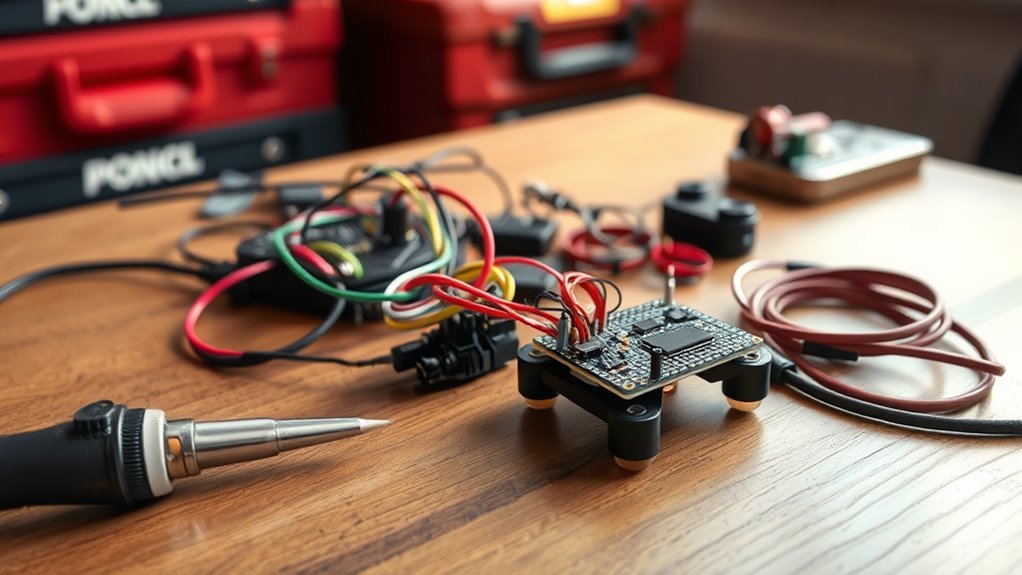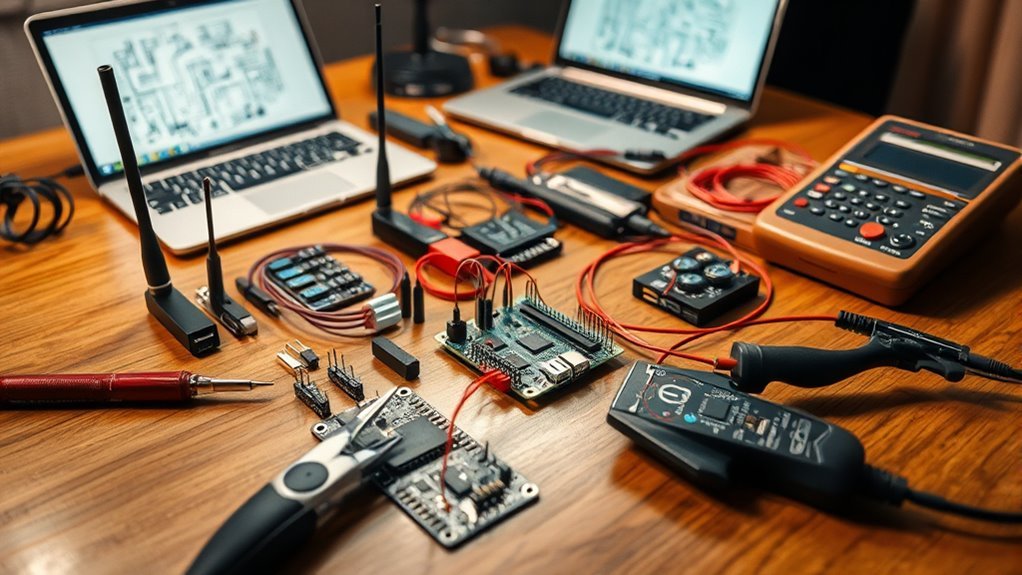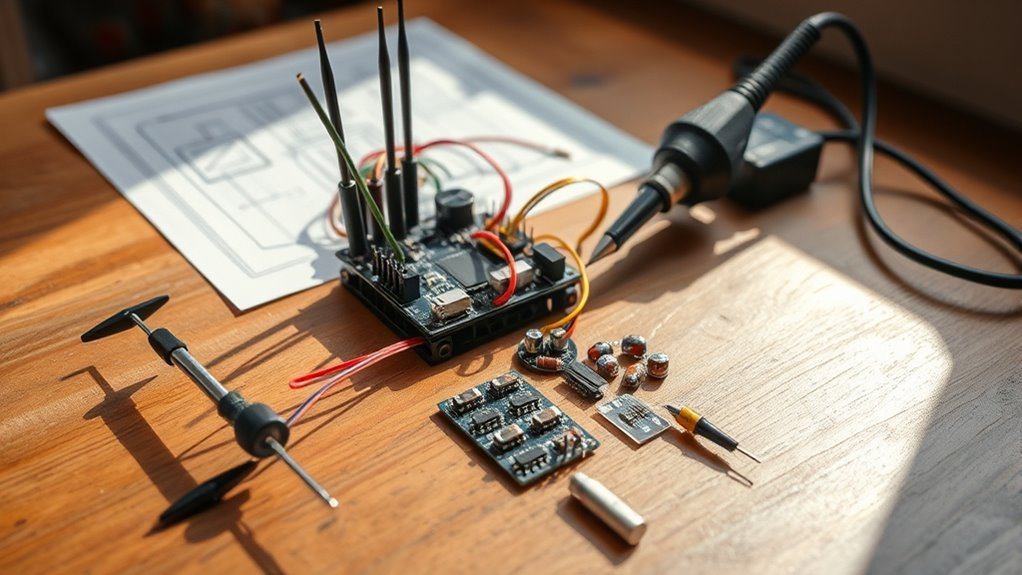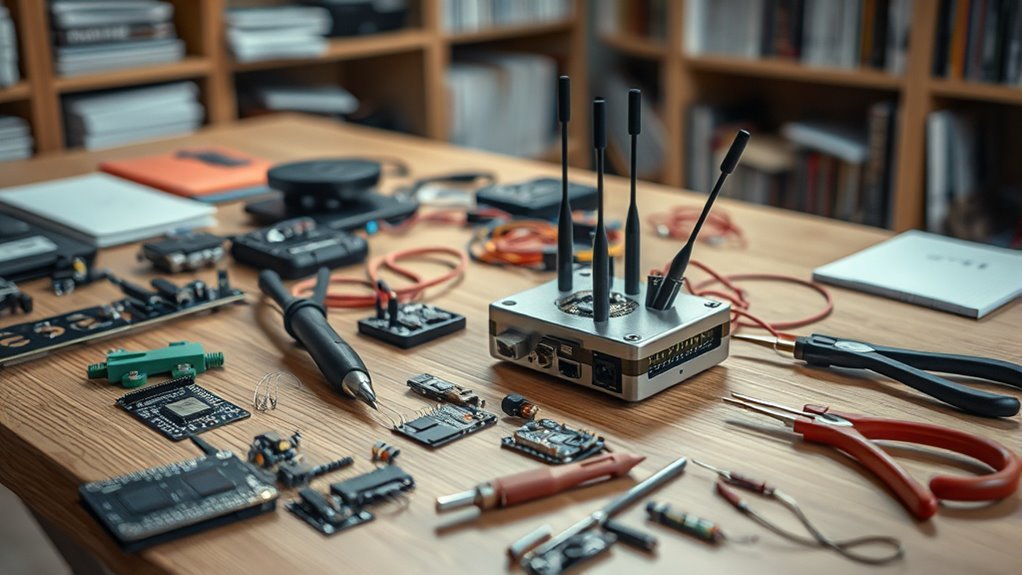To make a drone jammer, you’ll need to understand the technology behind signal interference. This involves using vital components like a power supply, oscillator, amplifier, and antennas. Assembling your device requires specific tools and adherence to legal regulations, as unauthorized jamming can result in hefty fines or criminal charges. Safety during use is essential to avoid unintended consequences. For a thorough overview of the assembly process and necessary precautions, further information awaits you.
Understanding Drone Jamming Technology

While you might be familiar with drones and their applications, understanding drone jamming technology is vital for grasping how to effectively disrupt their operations. Drone technology relies on signals for communication and navigation; therefore, signal interference becomes a significant tool in countering unauthorized drones. Jamming devices emit signals on the same frequency as the drone’s communication channels, leading to loss of control or data transmission. This interference can prevent drones from executing their intended missions, providing a layer of security for individuals or property. However, recognizing the implications of signal interference is important, as it can also hinder legitimate operations. Moreover, environmental conditions and electronic countermeasures play a crucial role in the effectiveness of jamming efforts. Mastering these technical aspects empowers you to navigate the freedom of drone usage responsibly while safeguarding your autonomy from unwanted surveillance or intrusion.
Legal Considerations Before Building a Jammer

Before you start building a drone jammer, it’s essential to understand the federal regulations that govern such devices. You’ll also need to take into account state law variations, as these can greatly impact your legal standing. Ignoring these factors could lead to serious legal consequences, including fines or criminal charges.
Federal Regulations Overview
Understanding federal regulations is essential if you’re considering building a drone jammer, as violating these laws can lead to severe legal consequences. The Federal Communications Commission (FCC) strictly regulates devices that can interfere with communications, placing jammers under federal jurisdiction. Regulatory compliance is critical, as unauthorized use can result in hefty fines or criminal charges.
Here’s a concise overview of key points:
| Aspect | Description | Consequence |
|---|---|---|
| Device Type | Jammers | Illegal under FCC regulations |
| Frequency Range | All communication bands | Potential fines up to $100,000 |
| Usage Restrictions | Public and private use prohibited | Criminal charges possible |
| Licensing Requirements | None for jammers | Immediate seizure of device |
| Enforcement Agency | FCC | Investigates violations |
Always consult legal experts before proceeding.
State Law Variations
As you consider building a drone jammer, it is vital to recognize that state laws can differ greatly from federal regulations, which may lead to additional legal complexities. Each state has its own set of regulations regarding electronic devices that interfere with communications. These state regulations can dictate whether you can legally construct or utilize a jammer. Local enforcement agencies may interpret these laws differently, leading to potential discrepancies in enforcement. Consequently, it is important to research your specific state’s stance on jamming devices and consult legal experts if necessary. Ignoring these variations could result in unwanted legal repercussions, undermining your pursuit of freedom while maneuvering through the intricacies of drone technology and its regulation.
Potential Legal Consequences
Given the intricate legal landscape surrounding jamming devices, you must carefully consider the potential consequences before proceeding with the construction of a drone jammer. The legal implications can be severe, including hefty fines or even imprisonment. Regulatory bodies like the FCC strictly prohibit unauthorized jamming. Furthermore, enforcement challenges arise as determining intent can be complex.
| Potential Consequences | Description | Severity Level |
|---|---|---|
| Fines | Financial penalties for violations | High |
| Imprisonment | Possible jail time for serious cases | Very High |
| Civil Liability | Lawsuits from affected parties | Medium |
| Equipment Seizure | Confiscation by law enforcement | High |
| Criminal Charges | Felony charges in extreme cases | Very High |
Essential Components for Your Drone Jammer

To build an effective drone jammer, you need to focus on several key components. You’ll require specific electronic parts, select appropriate antenna types, and guarantee you have reliable power supply options. Understanding these essentials will streamline your assembly process and enhance your jammer’s performance.
Required Electronic Components
Building an effective drone jammer requires a specific set of electronic components that work together to disrupt communication signals. Your component selection is vital for ideal circuit design. Here’s a breakdown of essential components:
| Component | Description |
|---|---|
| Power Supply | Provides necessary voltage |
| Oscillator | Generates jamming frequencies |
| Amplifier | Boosts signal strength |
| Modulator | Encodes data for transmission |
| Microcontroller | Manages the circuit operations |
These components must interact seamlessly to guarantee your drone jammer functions efficiently. Prioritize quality and compatibility during your component selection, as this will enhance reliability and effectiveness. By focusing on these essential elements, you’ll be well on your way to building a capable drone jammer.
Antenna Types Overview
While selecting the right antennas is essential for optimizing your drone jammer’s performance, understanding the different types available can greatly impact your design. There are several antenna types to evaluate, such as directional, omnidirectional, and patch antennas. Directional antennas focus signals in a specific direction, making them ideal for targeting drones at a distance. Omnidirectional antennas, on the other hand, emit signals in all directions, providing broader coverage. Finally, patch antennas offer a compact design while maintaining decent gain. Each antenna type has its unique advantages and drawbacks, so your antenna design should align with your operational goals and environment. By carefully selecting the appropriate antenna types, you can considerably enhance your jammer’s effectiveness and range.
Power Supply Options
Power supply options are critical components that directly influence the performance and reliability of your drone jammer. You’ll need to evaluate various battery types, such as lithium-polymer or lead-acid, each offering distinct advantages depending on your power requirements. Lithium-polymer batteries are lightweight and provide high energy density, making them ideal for portable applications. Furthermore, effective power management is essential; it guarantees that your jammer operates efficiently without draining the battery too quickly. Integrating a power management system helps regulate voltage and current, extending battery life while optimizing performance. Ultimately, selecting the right battery type and implementing robust power management strategies will enhance your drone jammer’s effectiveness, assuring you maintain control over your airspace.
Tools Needed for Assembly
Assembling your drone jammer requires a few essential tools to guarantee everything fits together correctly and functions as intended. First, gather a soldering iron and solder for secure electrical connections. You’ll also need wire cutters and strippers to prepare your wiring efficiently. For precision, a multimeter will help you test connections and verify functionality. A small screwdriver set is critical for securing components in place. Additionally, don’t overlook the importance of a heat shrink tubing kit to insulate your connections properly. As you proceed, refer to this tools overview and keep these assembly tips in mind to enhance your experience. By preparing adequately, you’ll confirm a smoother assembly process and a more effective final product.
Step-by-Step Assembly Instructions
Now that you’ve gathered your tools, it’s essential to understand the required components for your drone jammer. Each part plays a specific role in the assembly process, so you’ll need to follow a clear breakdown of steps to guarantee proper functionality. Let’s review the components and then proceed with the assembly instructions.
Required Components Overview
Creating an effective drone jammer requires a careful selection of components that work harmoniously together. Start with a suitable transmitter that can operate across multiple frequencies, as various drone types may utilize different communication protocols. You’ll need a power amplifier to enhance the signal strength for effective jamming techniques. Additionally, a microcontroller is essential for programming the jamming patterns specific to target drones. Antennas must be chosen based on the frequency range of the drones you intend to disrupt; omnidirectional antennas can provide broader coverage. Ultimately, you’ll need a power supply capable of supporting all components without interruption. By selecting these elements thoughtfully, you’ll be well on your way to crafting a functional drone jammer that upholds your right to privacy.
Assembly Process Breakdown
With the necessary components gathered, the next step involves meticulously assembling your drone jammer. You’ll need to employ precise assembly techniques to guarantee functionality and safety. Begin by connecting the power supply to the transmitter. Then, integrate the antenna, ensuring a secure fit. Finally, solder the circuit board connections carefully to avoid short circuits.
- Verify all connections are tight and secure.
- Test the power supply before final assembly.
- Enclose components in a protective case to prevent damage.
- Conduct a range test to guarantee effectiveness.
Testing Your Drone Jammer
Testing your drone jammer is a critical step to verify it functions as intended and meets your operational requirements. Begin by employing various drone detection methods to identify potential threats within your range. Activate your jammer in a controlled environment, guaranteeing you have a clear line of sight to monitor its effects on nearby drones. Conduct a jamming effectiveness assessment by observing the response of drones within the designated area. Take note of any variations in signal loss and operational disruption. It’s vital to document these results for future reference and adjustments. By meticulously testing your device, you’ll ascertain it effectively neutralizes drone threats while adhering to legal and ethical standards, thereby empowering your pursuit of freedom from unwanted aerial surveillance.
Safety Precautions During Use
While operating a drone jammer, it is essential to prioritize safety to prevent unintended consequences. You must recognize that user responsibility plays a significant role in ensuring operational safety. Here are key precautions to take into account:Prioritize safety when operating a drone jammer, as user responsibility is crucial for preventing unintended consequences.
- Always operate the jammer in a controlled environment.
- Keep a safe distance from people and property to minimize risks.
- Familiarize yourself with local laws regarding jamming devices.
- Regularly inspect your equipment for proper functionality.
Possible Alternatives to Jamming
Although jamming may seem like a straightforward solution to mitigate unauthorized drone activity, several alternatives can effectively address the issue without the legal and ethical implications associated with signal interference. One viable method is drone detection technology, which identifies and monitors drone presence using radar or RF analysis. This allows for real-time assessment of unauthorized flights while maintaining compliance with regulations. Additionally, employing geofencing technology can help restrict flight paths to prevent accidental intrusions into sensitive areas. Another alternative solution involves deploying physical barriers, such as nets or designated no-fly zones, to deter drones from entering sensitive areas. Additionally, engaging local authorities or security teams can provide a proactive approach to manage and resolve drone-related incidents. These strategies empower you to safeguard your airspace without resorting to disruptive measures like jamming. Furthermore, utilizing drone sanitization technology can enhance safety and efficiency in managing airspace by minimizing risks associated with unauthorized flights.
Maintaining Your Device
To guarantee your drone jammer operates effectively over time, regular maintenance is vital. Neglecting this can lead to subpar performance, so incorporating drone maintenance tips into your routine is important. Here are key steps to keep your device in top shape:
Regular maintenance is essential for your drone jammer to ensure optimal performance and reliability over time.
- Inspect Connections: Regularly check all wiring and connectors for wear or corrosion.
- Update Firmware: Verify your device runs the latest firmware for peak performance and security.
- Test Signal Range: Periodically assess the jamming range to confirm it’s functioning as intended.
- Clean Components: Dust and debris can hinder performance; clean your device gently and regularly.
Utilizing these device troubleshooting techniques will help you maintain your drone jammer, confirming its reliability and effectiveness when needed.
Keeping up With Drone Regulations
As drone technology evolves, staying informed about regulations becomes essential for effective operation and compliance. You need to understand the legal landscape surrounding drone privacy and aerial surveillance, as these areas are often heavily regulated. Familiarize yourself with local and federal laws that dictate where drones can be flown and the types of surveillance they can conduct. Violating these laws can lead to severe penalties, including fines or confiscation of your equipment. Additionally, emerging regulations may impact your ability to use drone jammers legally. Keeping abreast of these changes guarantees that you can operate freely without infringing on the rights of others or facing legal repercussions. NDAA compliance is also a critical factor that may influence your operational strategies and equipment choices. Moreover, understanding FAA regulations is vital to ensure that you remain compliant with the rules governing drone operations. Always prioritize ethical considerations while maneuvering this complex regulatory environment.
Frequently Asked Questions
Can I Use a Drone Jammer for Personal Security Purposes?
You might consider a drone jammer for personal safety, but be aware of the legal implications. Many jurisdictions prohibit their use, potentially leading to serious penalties. Always prioritize lawful methods for ensuring your security.
How Far Can a Drone Jammer Effectively Disrupt Signals?
Imagine a fortress of silence; a drone jammer’s signal range typically disrupts signals within 100 to 500 meters. However, its jamming effectiveness can vary based on technology, interference, and environmental factors, so results may differ.
Are There Any Risks of Jamming Nearby Devices?
When jamming signals, there’s a risk of unintended signal interference with nearby devices, potentially affecting communication and navigation systems. Additionally, you’ll face legal implications, as unauthorized jamming is generally prohibited under telecommunications regulations.
What Frequency Bands Do Most Drones Operate On?
Most drones operate primarily on 2.4 GHz and 5.8 GHz frequency bands for drone communication. Jamming within these ranges can lead to significant frequency interference, disrupting their operations and potentially granting you unprecedented control over the skies.
Can I Legally Use a Drone Jammer at Public Events?
You shouldn’t use a drone jammer at public events due to legal implications. While you may prioritize public safety, unauthorized jamming can lead to serious consequences, including fines and criminal charges, violating regulations surrounding wireless communications.

